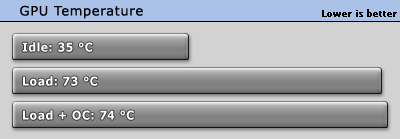 55
55
EVGA GTX 970 SC ACX 4 GB Review
Value & Conclusion »Temperatures

Temperatures are good, well below NVIDIA's 80°C temperature limit. Clocks will be reduced slightly, although never below the base clock, if the card gets any hotter than the limit. Our graph further down the page details the card's clock distribution.
However, given the relatively high noise levels I would have preferred the card to run slightly warmer, which should reduce noise because the fan wouldn't have to run as fast.
| GPU Temperature Comparison | ||
|---|---|---|
| Idle | Load | |
| EVGA GTX 970 SC ACX | 35°C | 73°C |
| ASUS GTX 970 STRIX OC | 47°C | 71°C |
| Palit GTX 970 JetStream | 49°C | 78°C |
| NVIDIA GTX 980 | 36°C | 80°C |
cooler design, and production variances. This table just serves to provide
a list of typical temperatures for similar cards determined during TPU review.
Clock Profiles
Modern graphics cards have several clock profiles that are selected to balance power draw and performance requirements.The following table lists the clock settings for important performance scenarios and the GPU voltage we measured. We performed the measurement on the pins of a coil or a capacitor near the GPU voltage regulator.
| GPU Clock | Memory Clock | GPU Voltage (measured) | |
|---|---|---|---|
| Desktop | 135 MHz | 162 MHz | 0.86 V |
| Multi-Monitor | 135 MHz | 162 MHz | 0.86 V |
| Blu-ray Playback | 135 MHz | 162 MHz | 0.86 V |
| 3D Load | 1164 - 1354 MHz | 1753 MHz | 1.025 - 1.218 V |
For the graph below, we recorded all GPU clock and GPU voltage combinations of our 1920x1080 resolution benchmarking suite. The plotted points are transparent, which allows them to add up to indicate more often used values. A light color means the clock/voltage combination is rarely used and a dark color means it's active a lot.

Mar 13th, 2025 07:34 EDT
change timezone
Latest GPU Drivers
New Forum Posts
- RTX5000 Series Owners Club (153)
- What's your latest tech purchase? (23292)
- RX 9070 availability (224)
- The TPU UK Clubhouse (25884)
- Cant Enable Resizable Bar (7)
- Will Asus USB4 ASMedia 4242 card work in a motherboard another manufacturer? (2)
- Oculus Rift S Green Tint Issue (1)
- Free Games Thread (4553)
- 3D Printer Club (451)
- How's your old spinner holding up? (48)
Popular Reviews
- AMD Ryzen 9 9950X3D Review - Great for Gaming and Productivity
- Sapphire Radeon RX 9070 XT Nitro+ Review - Beating NVIDIA
- XFX Radeon RX 9070 XT Mercury OC Magnetic Air Review
- FSP MP7 Black Review
- Dough Spectrum Black 32 Review
- ASUS Radeon RX 9070 TUF OC Review
- ASUS GeForce RTX 5090 TUF Review
- AMD Ryzen 7 9800X3D Review - The Best Gaming Processor
- NVIDIA GeForce RTX 5070 Founders Edition Review
- MSI MAG B850 Tomahawk Max Wi-Fi Review
Controversial News Posts
- NVIDIA GeForce RTX 50 Cards Spotted with Missing ROPs, NVIDIA Confirms the Issue, Multiple Vendors Affected (513)
- AMD Radeon RX 9070 and 9070 XT Listed On Amazon - One Buyer Snags a Unit (261)
- AMD RDNA 4 and Radeon RX 9070 Series Unveiled: $549 & $599 (260)
- AMD Mentions Sub-$700 Pricing for Radeon RX 9070 GPU Series, Looks Like NV Minus $50 Again (249)
- NVIDIA Investigates GeForce RTX 50 Series "Blackwell" Black Screen and BSOD Issues (244)
- AMD Radeon RX 9070 and 9070 XT Official Performance Metrics Leaked, +42% 4K Performance Over Radeon RX 7900 GRE (195)
- AMD Radeon RX 9070-series Pricing Leaks Courtesy of MicroCenter (158)
- AMD Radeon RX 9070 XT Reportedly Outperforms RTX 5080 Through Undervolting (102)